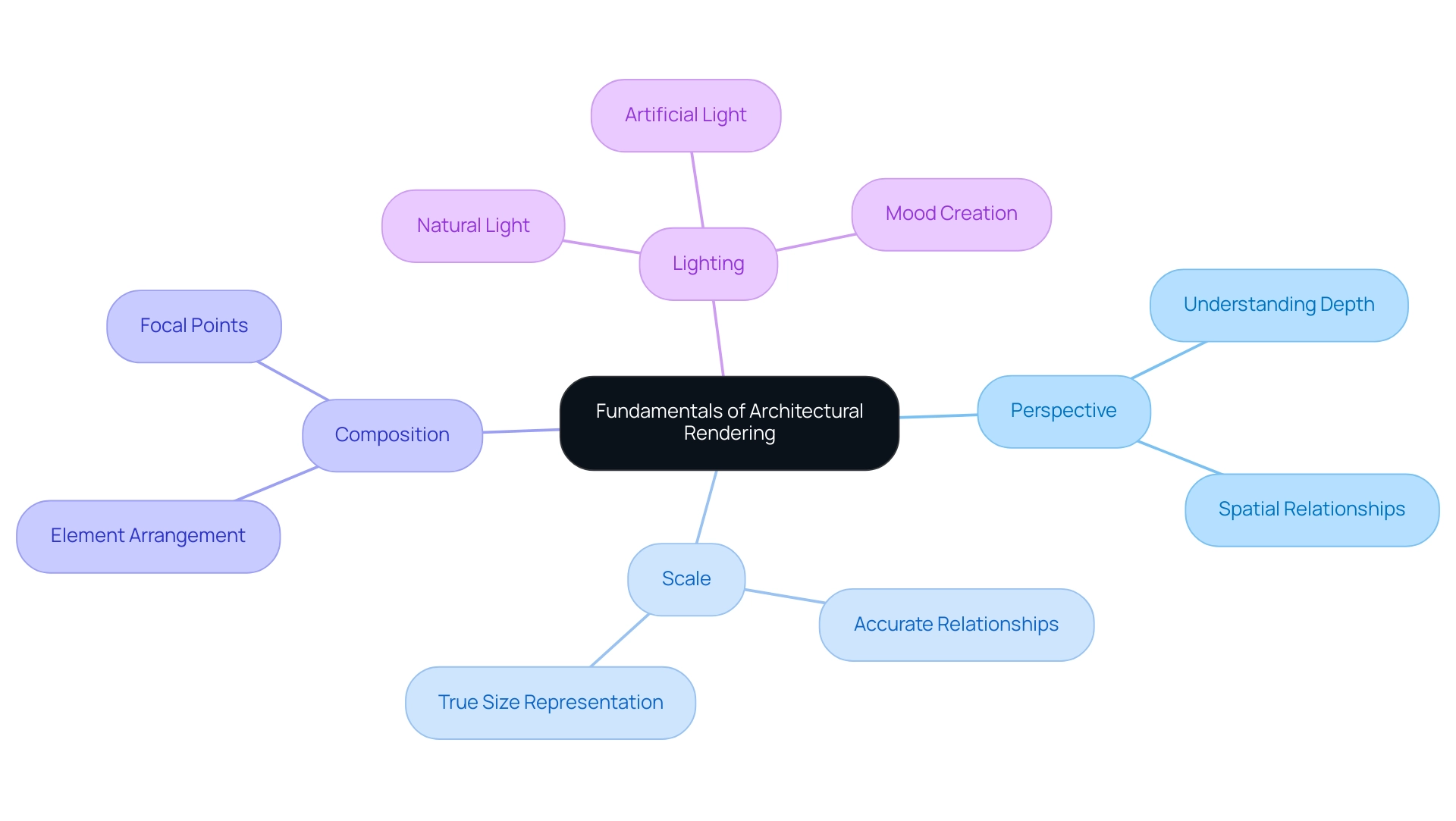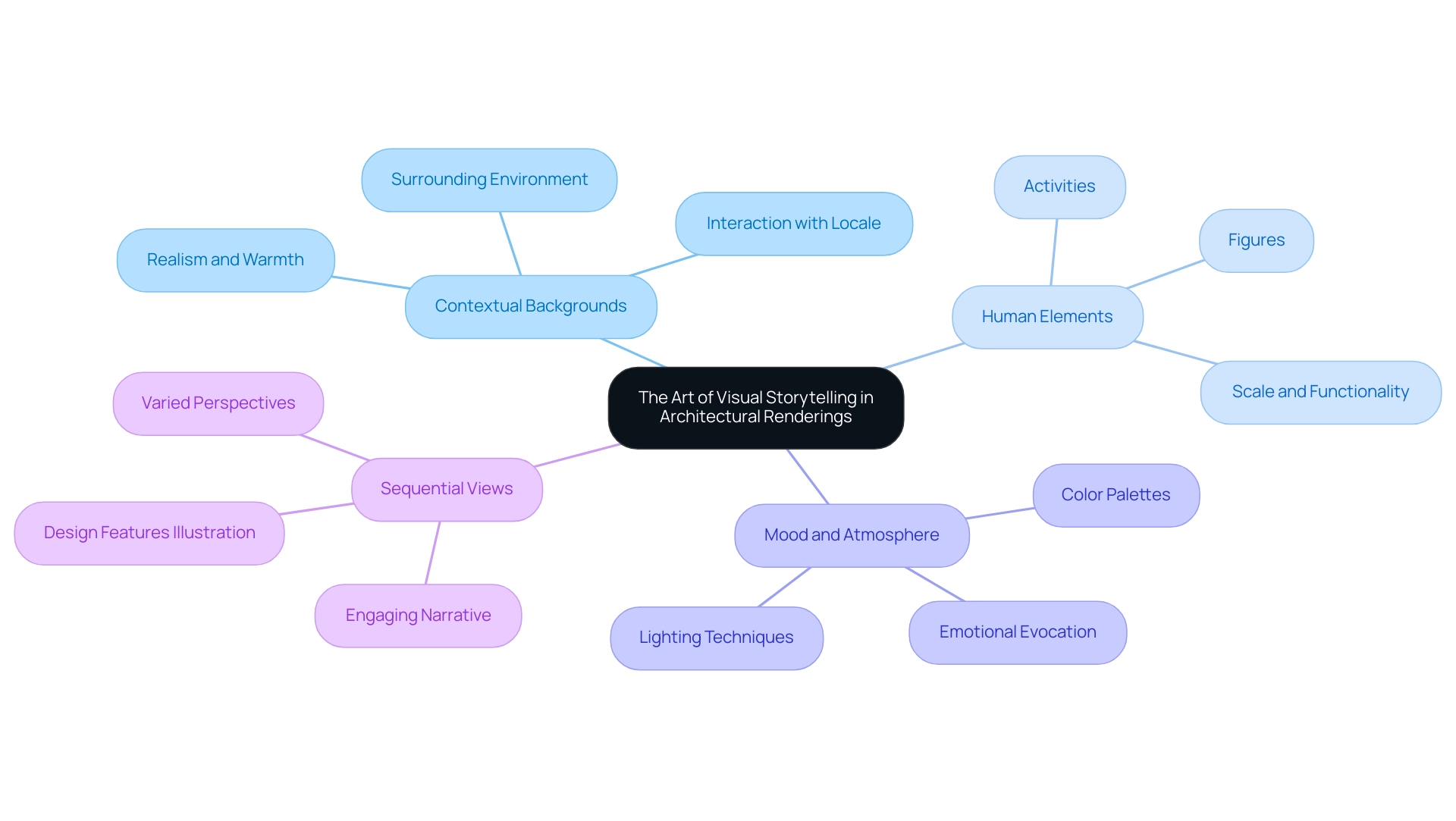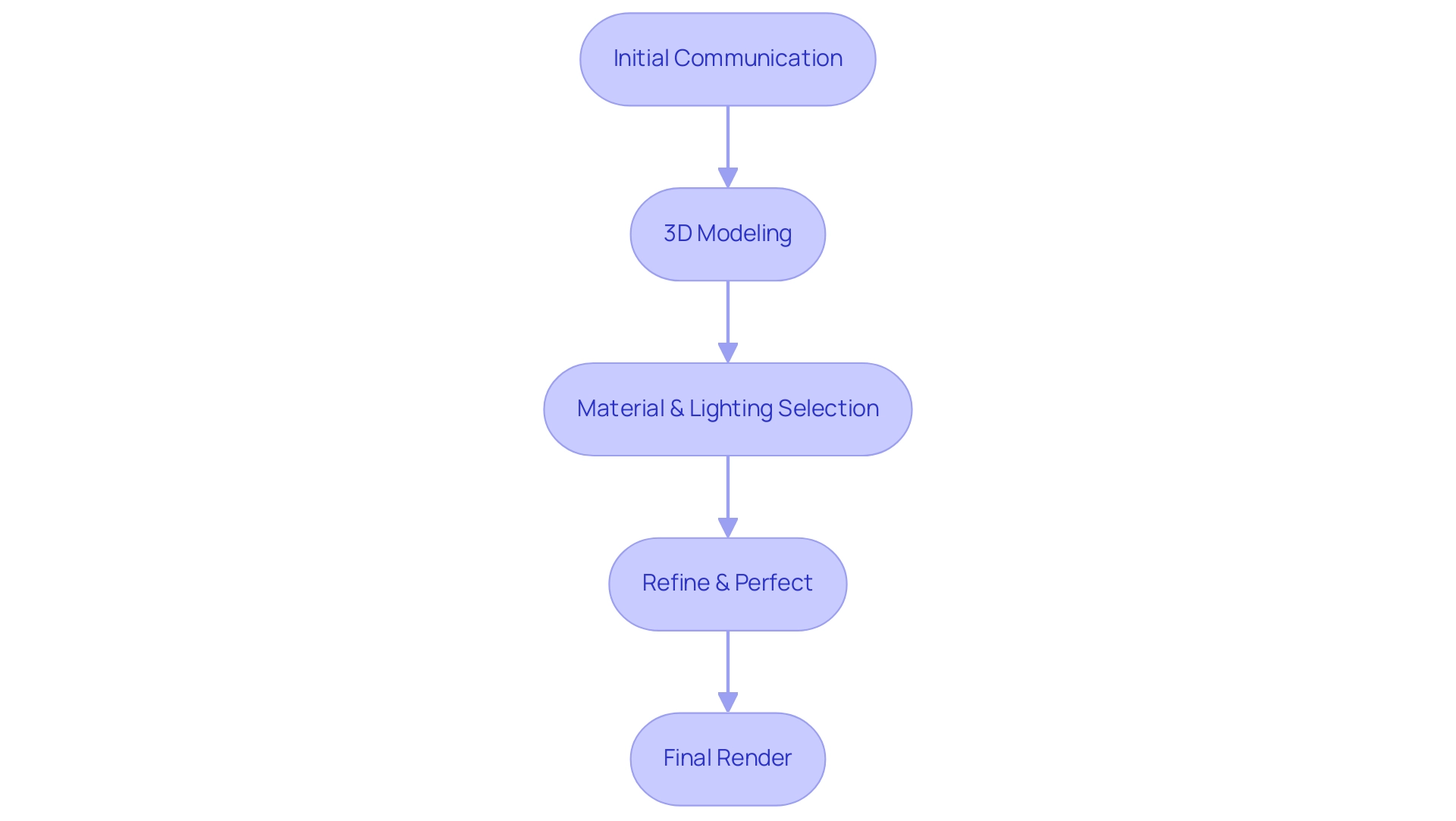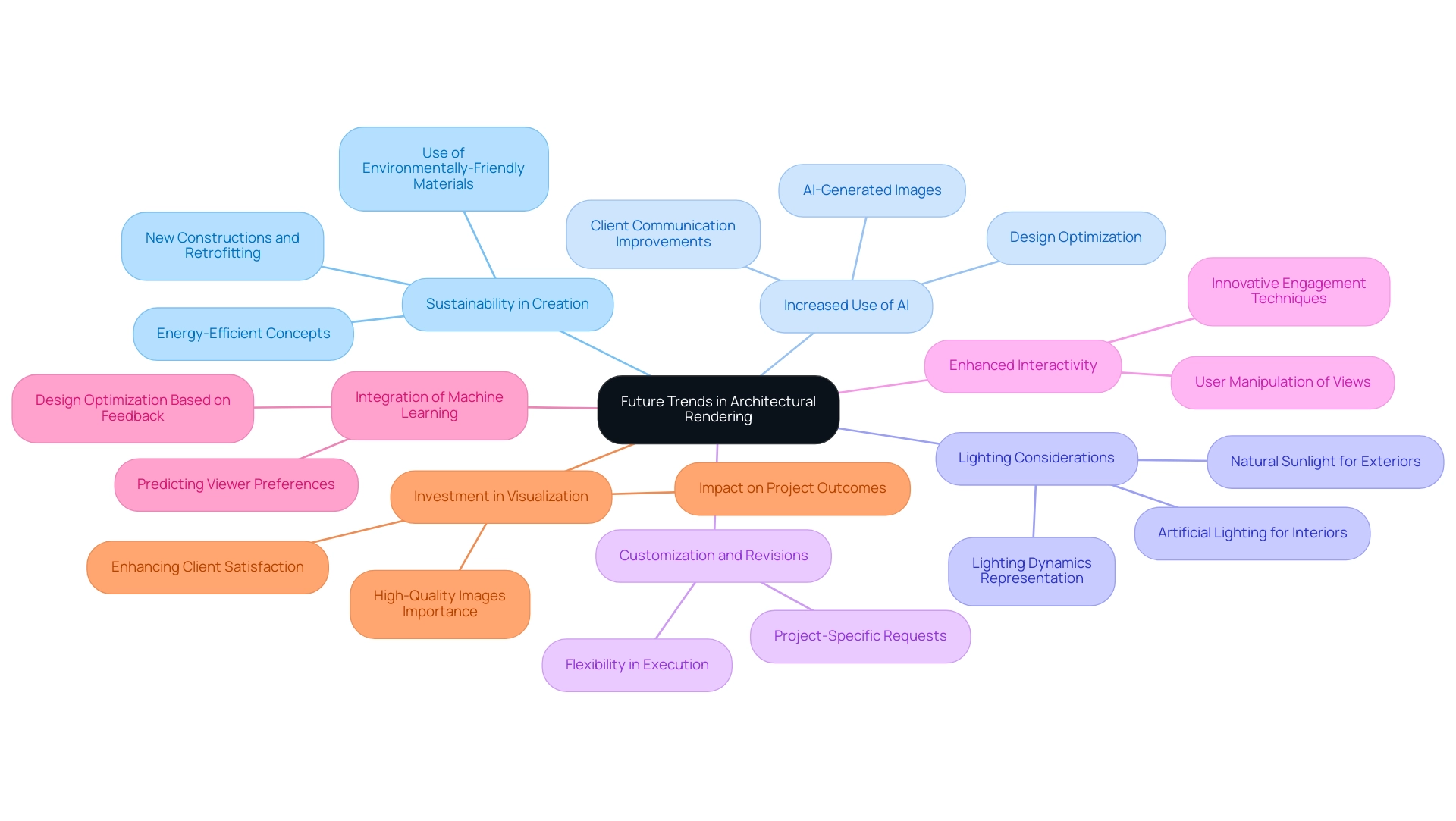Introduction
In the realm of architectural design, the ability to convey complex ideas through visual representation is paramount. Architectural rendering stands at the intersection of artistry and technology, transforming abstract concepts into tangible experiences that resonate with clients and stakeholders alike. This article delves into the essential principles and advanced techniques that underpin effective architectural renderings, exploring the significance of perspective, scale, and composition. It also highlights the role of cutting-edge technologies such as real-time rendering and virtual reality, which are redefining how architects communicate their visions. By mastering these elements, lead architects can not only enhance the clarity and impact of their presentations but also foster deeper connections with their audience, ultimately bridging the gap between design intent and construction reality.
Fundamentals of Architectural Rendering
Architectural concept rendering is a critical process in creating two-dimensional or three-dimensional images that accurately represent proposed designs. Mastering the following key concepts is essential for producing high-quality images:
- Perspective: A deep understanding of perspective manipulation is vital for imbuing renderings with realistic depth, allowing viewers to perceive spatial relationships effectively. This is particularly important given that, as Maya Lin remarked, buildings often do not match their original drawings, highlighting the need for accurate visual representation.
- Scale: Precise representation of scale is crucial; it ensures accurate relationships between objects and conveys the true size of architectural elements, which is often overlooked in practice.
- Composition: Thoughtfully arranging elements within the frame is necessary to guide the viewer’s eye and emphasize the design’s focal points, enhancing overall visual impact.
- Lighting: The strategic use of both natural and artificial light sources is essential to create mood and realism, significantly affecting how visuals are perceived. For instance, interior visualizations rely heavily on artificial light to simulate various conditions, while exterior images must adeptly capture the nuances of natural sunlight and its dynamic effects on the building facade throughout the day. Grasping the distinct challenges presented by lighting in both environments is essential for attaining a realistic depiction.
Acquaintance with these basics is not just theoretical; they provide the groundwork for more sophisticated visualization techniques. As Maya Lin appropriately expressed, ‘For the most part things never get built the way they were drawn’, highlighting the significance of representation in connecting the gap between intent and construction reality. Precise architectural concept renderings not only communicate the project intent but also help eliminate misunderstandings between contractors and customers, ensuring everyone is aligned on the vision.
Recent advancements in architectural concept rendering technologies, including real-time rendering and virtual reality integration, have empowered architects to enhance visual precision and storytelling in their presentations. By mastering these core concepts, lead architects can ensure their visualizations not only meet the technical demands of the field but also resonate with clients and stakeholders, facilitating better communication and understanding throughout the creation process. Moreover, identifying potential issues early in the design process is a key advantage of utilizing 3D visualizations, ultimately saving time and resources.
Techniques and Tools for Effective Architectural Rendering
To create compelling architectural renderings, it is essential to master specific techniques and utilize effective tools:
3D Modeling Software: Proficient use of programs such as SketchUp, Revit, and Rhino is critical for developing precise models. SketchUp, in particular, is lauded for its user-friendly interface and extensive library of 3D objects, making it an excellent choice for beginners while still offering advanced functionalities for more experienced users. As highlighted in a case study, SketchUp’s collaboration capabilities through Trimble Connect enhance its usability in team settings, allowing for meticulous detail and client collaboration.
Visualization Engines: Implementing robust visualization engines like V-Ray, Lumion, or Enscape can significantly enhance the quality of visual outputs. Each engine provides unique capabilities designed for different visualization needs, with V-Ray being especially recognized for its photorealistic outcomes and Lumion excelling in real-time visualization and animation. The selection of visualization engine can also affect the overall project budget, a significant factor for architects.
Texturing: The application of realistic textures through comprehensive materials libraries is vital to elevate the visual appeal of your models. Utilizing high-quality textures can drastically improve the authenticity of renderings, making them more engaging for customers and stakeholders, thereby enhancing satisfaction.
Lighting Techniques: Mastering effective lighting setups, such as three-point lighting or HDRI (High Dynamic Range Imaging), is crucial for achieving depth and realism in architectural visualizations. Proper lighting can dramatically transform the mood and perception of a space, ultimately influencing the emotional connection clients feel toward the layout.
Post-Processing: Refining your images with software like Adobe Photoshop or Lightroom allows for adjustments in color balance, contrast, and the addition of effects to finalize the rendering. This step is vital for refining an image, ensuring it connects effectively with the target audience and highlights the functionality and aesthetics of the creation.
Moreover, the role of pre-sales visualization cannot be overstated; it enhances project confidence and generates investment by offering stakeholders a clear vision of the final product, fostering trust and excitement about the project’s potential. As Deniz D. noted, “It’s a great experience, I’ve learnt a lot about it like how to use parametric design & merge it with industrial objects for example chairs, sneakers so far and so on.” By honing these tools and techniques, architects can produce architectural concept renderings that not only convey their creative vision but also engage and impress clients and stakeholders alike, enhancing project confidence and generating investment.
The Art of Visual Storytelling in Architectural Renderings
Effective architectural concept rendering is not merely a visual representation; it tells a story that resonates deeply with viewers. Incorporating the following elements can significantly enhance the storytelling aspect of renderings:
Contextual Backgrounds: Integrating elements of the surrounding environment provides essential context for the creation, allowing viewers to appreciate how the structure interacts with its locale, thus enhancing the emotional connection to the project.
For instance, the way sunlight dances off the windows and the subtle texture of the bricks can create a sense of realism and warmth.Human Elements: Including figures or activities within the scene is crucial for depicting scale and functionality. This approach enables viewers to envision the space in use, establishing a connection that transcends the mere physical structure and fostering a sense of community among future residents.
Mood and Atmosphere: The strategic use of lighting and color palettes plays a pivotal role in evoking emotions. Whether striving for the tranquility of a residential home or the vibrancy of a commercial space, the right mood can enhance the viewer’s experience and interpretation of the concept, making the project feel real and lived-in.
Sequential Views: Creating a series of images that direct the viewer through the layout offers varied perspectives and functionalities. This technique not only illustrates the design features but also invites viewers to engage with the narrative of the space, showcasing the concept in a unique way.
By thoughtfully incorporating these storytelling techniques, architects can create architectural concept renderings that engage viewers effectively and communicate their vision with clarity. The recent success of the Meerstad Groningen project, awarded first prize in a design competition, underscores the importance of such narratives. This project, a collaboration between Bemog Projektontwikkeling, LAP Landscape & Urban Design, and MIX architectuur B.V., exemplifies how storytelling in architectural presentations can lead to recognition and impact in the field.
As RNDR aptly states, this technique allows architects to present their architectural concept renderings in a creative and unique way, showcasing the concept in a manner that differs from the conventional photorealistic approach. By integrating human elements and focusing on storytelling techniques, architects can enhance their visualizations, ultimately enriching the viewer’s experience and fostering deeper connections with their designs. Furthermore, the immersive impact of building visualization plays a crucial role in fostering community connections, making future homeowners feel a part of the narrative even before construction begins.
In summary, investing in high-quality visuals is not solely about appearance; it’s about ensuring that the initial impression matches the design concept and the completed construction.
Leveraging Technology in Architectural Rendering
In the rapidly changing environment of architectural creation, the incorporation of architectural concept rendering and sophisticated visualization technologies is essential for improving project results. At J. Scott Smith Visual Designs, we emphasize a collaborative process for architectural concept rendering that begins with initial communication and project understanding, leading to detailed 3D models that capture the vision with precision. Key technologies that architects should prioritize include:
Real-Time Rendering: Utilizing platforms like Twinmotion and Unreal Engine enables real-time visualization, allowing architects to make immediate adjustments and showcase dynamic concepts to stakeholders.
Virtual Reality (VR): VR technology provides immersive experiences that allow users to virtually navigate through spaces before construction commences, fostering a deeper understanding of the design.
Cloud Rendering: Services such as RenderStreet and V-Ray Cloud expedite the rendering process by offloading computational demands to the cloud, optimizing local resources and reducing turnaround times.
Augmented Reality (AR): By incorporating AR, architects can overlay digital models onto physical environments, enriching presentations and enhancing project proposals with interactive elements.
The impact of architectural concept rendering technologies is profound. For example, Tina from ASPA KST architecture planning expressed her team’s enthusiasm about using 3D renders to convince juries, contributing to their success in obtaining project approval. She stated, “Our team was excited to use these 3D renders to persuade the juries and win the plan.”
Her team rated the service five stars, highlighting the effectiveness of these techniques in enhancing user engagement and satisfaction.
Furthermore, our joint creation phase involves producing iterative architectural concept renderings based on client feedback, ensuring that each visual representation aligns with expectations. The 3D modeling phase is essential as it offers the initial perception of the concept. Our team employs Rhino 3D and 3ds Max to refine the model, ensuring accuracy in shape, materials, and lighting.
During the Material & Lighting Selection phase, we meticulously create materials that reflect your intent and place virtual lights to simulate real-world conditions, enhancing the overall visual experience. After refining the model and sharing it with customers, we actively incorporate their feedback for continuous improvement in the Refine & Perfect phase. By embracing these innovations, architects can enhance efficiency, engage clients, and create architectural concept renderings that genuinely represent their design vision, with final aerial view images achieving resolutions of 7k and eye-level night views at 5k.
Your Next Step to Transform Vision into Reality: Ready to bring your design vision to life with stunning clarity and precision? Our professional 3D modeling services can help turn your concepts into compelling visual realities that inspire confidence and drive project success. Whether you’re an architect, designer, or developer, our expert team has the tools and expertise to meet your specific needs.
Future Trends in Architectural Rendering
As building visualization continues to progress, several crucial trends are influencing the environment that designers must closely observe:
Sustainability in Creation: There is a growing focus on sustainable methods that will greatly impact visuals, highlighting the use of environmentally-friendly materials and energy-efficient concepts. This trend reflects the growing expectation for architects to incorporate sustainability into their work, as highlighted by Ali Sayigh, who notes that modern design solutions must address both new constructions and the retrofitting of existing structures.
This approach allows moving beyond reliance on precedent imagery, which is often limited to past work or abstract diagrams.Increased Use of AI: The integration of artificial intelligence is transforming the rendering process, automating various tasks from image generation to design optimization. AI is especially crucial in generating lifelike CG humans, which bridge the uncanny valley in visualizations.
Architectural firms, such as Wardle, have successfully leveraged AI-generated images for architectural concept rendering to enhance client communication during the initial stages of conceptual development. This case study exemplifies a broader trend of utilizing AI tools to improve visualization processes, demonstrating the value of AI in enhancing the clarity and effectiveness of design concepts.Lighting Considerations: The role of lighting cannot be understated in architectural visualizations.
Interior visuals depend significantly on artificial lighting to establish a realistic atmosphere, whereas exterior visuals are mainly shaped by natural sunlight. Effective representation of lighting dynamics, including how it interacts with various materials, is essential for achieving realism in both settings.Customization and Revisions: Every project is unique, and the need for customization and revisions significantly influences the investment in executing projects.
This flexibility enables architects to address specific requests, ensuring that the final visualizations align precisely with their vision.Enhanced Interactivity: Future rendering techniques are likely to incorporate interactive elements, enabling users to manipulate views and engage with creations in innovative ways.
This level of interactivity could revolutionize how architects present their concepts, fostering a deeper understanding for customers and stakeholders.Integration of Machine Learning: The application of machine learning algorithms holds the potential to predict viewer preferences and optimize designs accordingly.
By analyzing user interactions and feedback, architects can refine their visualizations to better meet customer expectations.Investment in Visualization: High-quality images are crucial for making informed decisions and building excitement about projects.
They serve as a window into the future, allowing stakeholders to visualize the potential and understand the vision behind the blueprints. This investment in quality not only enhances project development but also significantly impacts client satisfaction and project outcomes.
By staying attuned to these trends and recognizing the importance of high-quality architectural concept rendering, designers will not only enhance their expertise but also position themselves at the forefront of innovation in architectural visualization.
Conclusion
Architectural rendering is an indispensable tool in the design process, serving as a bridge between conceptual ideas and their physical realization. By mastering fundamental principles such as perspective, scale, composition, and lighting, architects can create visually compelling renderings that accurately communicate their design intent. The integration of advanced technologies, including real-time rendering and virtual reality, further enhances the ability to present dynamic and engaging visual narratives, fostering a deeper connection with clients and stakeholders.
Furthermore, employing effective techniques and tools, such as 3D modeling software and robust rendering engines, plays a critical role in elevating the quality of visual outputs. The art of visual storytelling, through the inclusion of contextual backgrounds and human elements, transforms renderings into powerful narratives that resonate with viewers. As trends in sustainability and artificial intelligence continue to shape the future of architectural rendering, architects must remain adaptable and forward-thinking, embracing these innovations to enhance their practice.
Ultimately, the commitment to producing high-quality renderings not only enriches the client experience but also drives project success. By investing in precision and clarity in visual communication, architects can ensure that their designs are not only seen but truly understood, paving the way for successful collaborations and impactful built environments. As the field continues to evolve, staying abreast of technological advancements and trends will be crucial for architects aspiring to lead in the competitive landscape of architectural design.






0 Comments